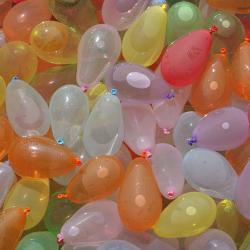Source Institutions
Source Institutions
Add to list Go to activity
Activity link broken? See if it's at the internet archive

In this activity, learners measure the diameter of their water balloons, model an impact, measure the diameter of the “crater” area, and determine the ratio of impactor to crater. This activity is best suited for the outdoors, in an area where there is plenty of concrete but no cars.
- 10 to 30 minutes
- 10 to 30 minutes
- $1 - $5 per group of students
- Ages 8 - 14
- Activity, Experiment/Lab Activity, Lesson/Lesson Plan, Model
- English
Quick Guide
Materials List (per group of students)
- Water balloons
- Nozzle to help inflate balloons
- Water hose
- Concrete patio or parking lot area
- Rulers
- Paper and pencils
Subjects
-
Earth and Space Science
- Astronomy
-
Solar System
- The Moon
- The Planets
- Asteroids and Comets
-
Mathematics
-
Data Analysis and Probability
- Data Collection
- Geometry
-
Measurement
- Size and Scale
- Circles
-
Number and Operations
- Fractions
-
Data Analysis and Probability
-
The Nature of Science
-
The Scientific Process
- Conducting Investigations
- Gathering Data
- Formulating Explanations
- Communicating Results
-
The Scientific Process
Informal Categories
- Outdoor Activity
- Toys
Audience
To use this activity, learners need to:
- see
- read
- be mobile
- touch
Learning styles supported:
- Involves hands-on or lab activities
Other
Includes alignment to state and/or national standards:
This resource is part of:
Access Rights:
- Free access
By:
Rights:
- , Lunar and Planetary Institute, 2014
